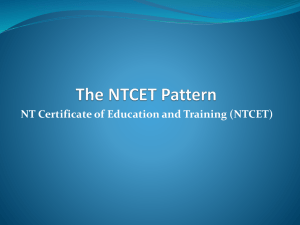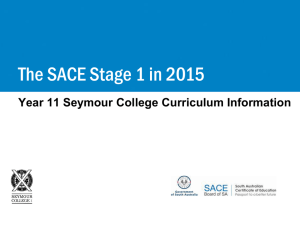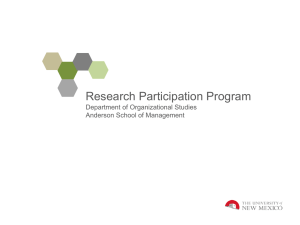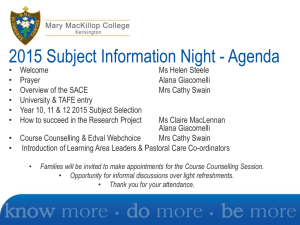Powerpoint - Seymour College
advertisement
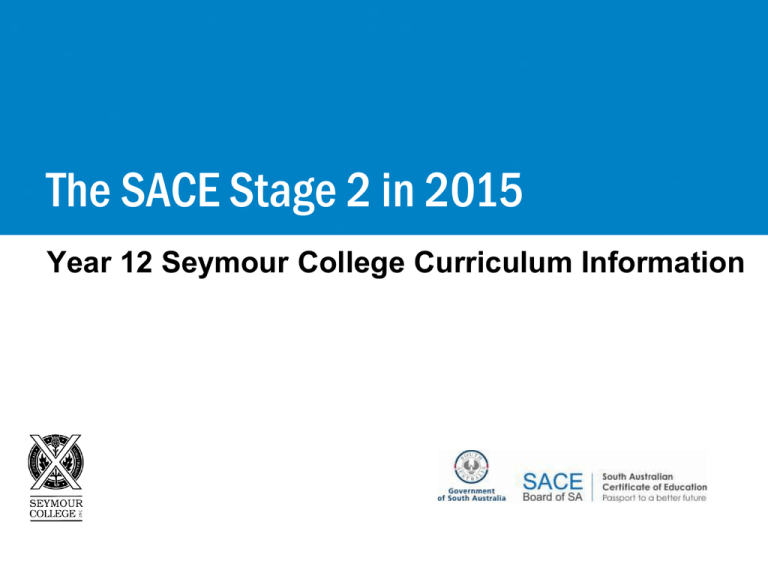
The SACE Stage 2 in 2015 Year 12 Seymour College Curriculum Information Information Good decisions • Senior School Curriculum Guide 2015 • Web Based Preferences Access Guide • 2015, 2016, 2017 SATAC Information Book • Subject Selection Interview What is the SACE? • The South Australian Certificate of Education • Awarded to students who successfully complete their senior secondary education • Internationally recognised • Leads to work, training and further study Features of the SACE Students earn credits for completed subjects: • One semester is worth 10 credits • Stage 2 whole year subjects 20 credits • Students must complete courses adding up to at least 200 credits, over two years • Students need to gain a C- grade or higher for compulsory subjects to gain the SACE Compulsory subjects • Personal Learning Plan – 10 credits Year 10 • Literacy – 20 credits • Numeracy – 10 credits • Research Project – 10 credits Stage 1 Assessment • In Stage 2 or Year 12, student work is graded from A+ to E- • Teachers assess 70% of student work, and 30% is assessed by the SACE Board School assessment – 70% • A sample of student work from every school is sent to the SACE Board for checking • Assessment experts check to ensure grades are accurate, fair and comparable with other SACE students • Sometimes grades are adjusted through this process which is called ‘moderation’ External assessment – 30% • The SACE Board marks the externally assessed component of all subjects • These assessments can be written or oral examinations, investigations or performances • Most exams take place in October and November • The exam timetable is available on the SACE website early each year Recognised learning The SACE recognises learning in and outside school, for example: • Vocational Education and Training courses (VET) • University and TAFE courses • Community learning www.sace.sa.edu.au/subjects/recognisedlearning Vocational Education and Training (VET) • Students can undertake hands-on learning in a workplace setting and get a head start on a career • They learn on-the-job skills while working towards both the SACE and a VET qualification • Students can gain up to 150 of their 200 SACE credits at Stage 1 and/or Stage 2 from VET University, TAFE and other courses • Students who complete a Certificate III or higher may count the qualification towards their ATAR • The SACE also recognises university studies, interstate and overseas senior secondary school qualifications and language courses Community learning • Students can count up to 90 credits of community learning at Stage 1 or Stage 2 • Programs such as the Duke of Edinburgh’s Award, Country Fire Service Training, and Australian Music Exams are recognised • Students may also receive credits for playing sport at an elite level, acting as a carer, or gaining a pilot’s licence Successful completion of the SACE leads to work or further tertiary study • 2016 TAFE SA entry requirements • 2016 University entry requirements Australian Tertiary Admission Rank (ATAR) • Measures a student’s overall achievement compared with other students • Used by universities to select students for university courses • Ranges from 0 to 99.95 • Calculated from university aggregate – based on 90 credits of SACE Stage 2 for entry in 2016. • Used across Australia and internationally Applying for 2016 university entry To be eligible, students will need to have: • Completed the SACE with at least 90 Credits at Stage 2 • Gained an ATAR • Gained a university aggregate • Met any prerequisite subject requirements • Complied with rules regarding subject combinations and counting restrictions Applying for TAFE • SACE meets TAFE SA Course Admission Requirements for most courses • TAFE SA considers other qualifications and experiences How the university aggregate is calculated 60 + 30 = 90 60 Three 20 credit scores 30 Final 30 credits flexible options Scaled scores from three 20 • This can come from the credit subjects. scaled score of a 20 Unless they are studied in credit subject pairs (as in Music) 10 credit • ½ the scaled score of subjects do not count here. one or more 20 credit subjects • The scaled score of one or more 10 credit subjects • The scaled scores of Recognised Learning to a maximum of 20 credits What is a scaled score? Scaling is the mathematical process which provides a basis for comparing performance in Stage 2 SACE subjects which have different objectives, content and assessment practices. • They come from the assessment results used by the SACE Board - the final subject grades. • They enable the results from different subjects to be directly compared. • They contribute to the aggregate and ATAR. • They enable students who have done completely different SACE study patterns to be directly compared in the selection process for entry to University and TAFE SA courses. So what does this look like at Stage 2? • Students aiming for tertiary study and an ATAR must successfully gain 90 credits Year 12 Stage 2 Research Project (completed in Stage 1) 10 credits (B) Stage 2 Option 1 – compulsory 20 credits (C- ) Stage 2 Option 2 – compulsory 20 credits (C- ) Stage 2 Option 3 – compulsory 20 credits (C- ) Flexible Option 30 credits (C- ) Stage 2 Subjects at Seymour • • • • • • • • • • • • • Accounting Biology Business & Enterprise* Chemistry Drama English as a Second Language English Communications* English Pathways* English Studies Food and Hospitality* French German History • • • • • • • • • • • • • Information Processing & Publishing* Legal Studies Mathematical Applications Mathematical Methods Mathematical Studies Music* Nutrition* Physical Education Physics Psychology* Society & Culture* Specialist Mathematics Visual Arts* All Stage 2 subjects at Seymour are classed as Tertiary Admissions Subjects (TAS ) * 10 credit subjects What might my course of study look like? Five subjects at Stage 2 Year 12 Stage 2 Research Project (completed in Stage 1) 10 credits (B) Stage 2 Option 1 – Mathematical Stage 2 Option 2 - Specialist Studies Mathematics Stage 2 Option 3 – Physics 20 credits (C- ) 20 credits (C- ) 20 credits (C- ) Stage 2 Option 4 - Chemistry 20 credits (C- ) Stage 2 Option 5 - French 20 credits (C- ) Another version Year 12 Stage 2 Research Project (completed in Stage 1) 10 credits (B) Stage 2 Option 1 – English Studies 20 credits (C- ) Stage 2 Option 2 - Visual 20 credits (C- ) Arts Stage 2 Option 3 – Music: Stage 2 Option 4 - Ensemble Performance Solo Performance Drama 20 credits (C- ) Stage 2 Option 5 - Society and Culture* 10 credits (C- ) 20 credits (C- ) SATAC – South Australian Tertiary Admissions Centre • Universities use Selection Ranks to determine entry to courses • This is the ATAR + Bonus Points • One size fits all – except for medicine, Veterinary Bioscience • The SA Universities Equity Scheme • The SA Language, Literacy and Mathematics Bonus Scheme The SA Language, Literacy and Mathematics Bonus Scheme • The scheme aims to encourage students to strengthen their preparation for university studies • LOTE • English Studies • English Communications • Mathematical Studies • Specialist Mathematics • 2 points per subject up to a maximum of 4 points Special Provisions • Available if an illness, disability or unforeseen circumstance significantly impacts a student’s ability to participate in an assessment • To apply, student must provide evidence of impact • More information is on the SACE website under Students and Families > Special Provisions • Seymour will assist those students in need. Further information Important Dates • Subject Selection Survey Forms due Friday, 15 August 2014 • Subject Selection Interviews Year 12 2015 – Wednesday, 27 August 2014 Key Personnel • • • • • • • • Ruth Massie Leonie Harwood: Co- Deputy Principal Lisa Parsons: Head of Senior School Michelle Stoutjesdijk: Careers Counsellor Maria de Lima: SACE Co-ordinator Faculty Heads Clan Guardians Subject Teachers Questions?
